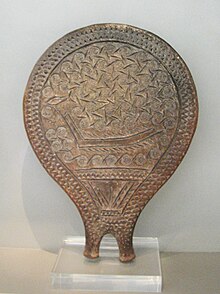
Back Paelles ciclàdiques Catalan Sartenes cicládicas Spanish Kykladiset paistinpannut Finnish Poêle à frire (Cyclades) French Wajan gorèng JV Kikladska ponev Slovenian



Frying pans is the descriptive nickname for a type of Early Cycladic II artifacts from the Aegean Islands around 2700-2200 BCE. They are flat circular disks with a "handle", and usually made from earthenware, but sometimes stone (Frying pan (Karlsruhe 75/11) is an example). They are found especially during the Cycladic Grotta-Pelos and Keros-Syros cultures. Their purpose remains unknown, although they are usually interpreted as prestige goods.
One side is usually undecorated, and the main zone is surrounded by a raised rim; this is usually regarded at the top side. The other side, regarded as the reverse, is usually slightly wider and highly decorated by incision in the clay, evidently with considerable care, and sometimes using wooden stamps for repeated motifs.[1]
They have been found at sites throughout the Aegean but are not common: around 200 have been unearthed to date, all but a handful in pottery. They are usually found in graves, although they are very uncommon grave goods; the rarity of these objects has contributed to the difficulty in identifying their true purpose.[2]
- ^ Hood, Sinclair, The Arts in Prehistoric Greece, 1978, Penguin (Penguin/Yale History of Art), ISBN 0140561420, p. 33
- ^ John E. Coleman, Frying Pans of the Early Bronze Age Aegean Archived 2016-04-17 at the Wayback Machine, American Journal of Archaeology, vol. 89, (1985), pp. 191-219.
© MMXXIII Rich X Search. We shall prevail. All rights reserved. Rich X Search